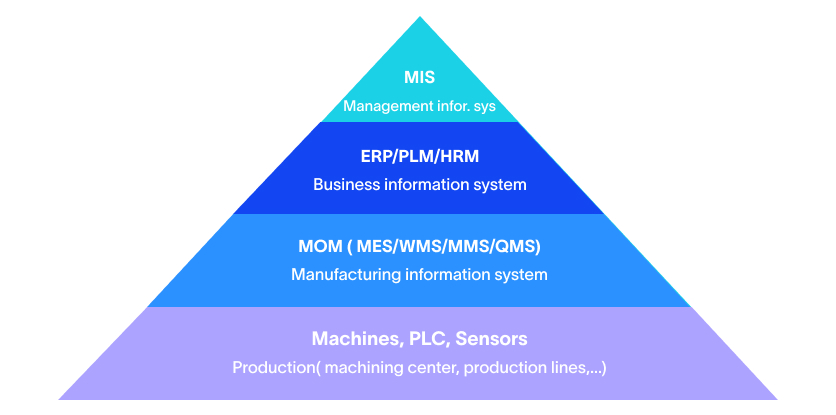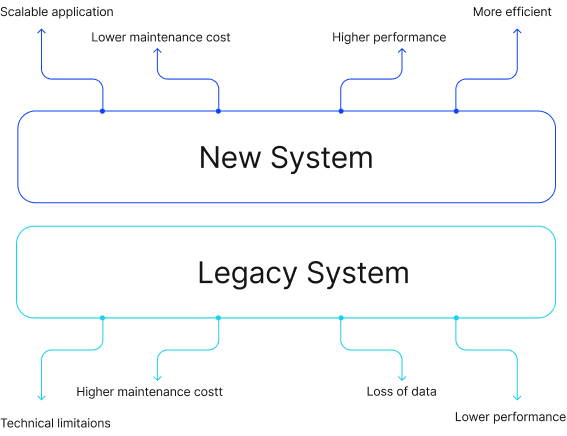Digital Twins in Manufacturing: The Complete Guide to Smart Factory Transformation
Blog
4 Min 40 Sec Read
Digital twin technology is a leading technology and innovative solution for manufacturing businesses. The use of emerging technologies such as IoT allows digital twin systems to transform the manufacturing process.
According to IoT analysis, 29% companies have implemented digital twin strategies in 2023. The number and rate of adoption are only growing with the digital twin industry expanding to $137.67 billion by 2030.
Despite being an essential and transformative technology in the manufacturing industry, manufacturing leaders face challenges with the implementation process.
Most of them are concerned about the rising costs and constant pressure to optimize production while maintaining quality.
Falling behind isn’t an option in the Industry 4.0 era. That’s why we have curated this guide to implement digital twin technology to achieve a smart manufacturing process and an efficient production line for aspiring manufacturing companies. Read on.
What is a Digital Twin in Manufacturing?
Digital twin in manufacturing virtualizes your manufacturing process in real time. Usually, this process includes digitizing your manufacturing process, from individual manufacturing lines to the entire production line.
In contrast to the static models, the digital twin manufacturing process continuously updates the manufacturing operation. It leverages live information from the Industrial IoT (IIoT) sensors, SCADA systems, and Manufacturing Execution Systems (MES).
This revolutionary solution in the manufacturing sector exists to mirror the conditions and the performance of the physical assets. Therefore, it provides clear visibility over the production lines to the manufacturers.
A simple explanation? Manufacturers can think of owning a magic crystal ball, giving them visibility over the manufacturing process at different stages. Additionally, the visibility spans the entirety of manufacturing, predicting failures, optimizing processes, and making data-driven decisions without ever disrupting production.
Explore the role of AI, IIoT, and advanced analytics in shaping the future of smart factories.
How Digital Twin Technology Helps with Manufacturing Optimization
Digital twin technology is transforming the manufacturing industry by optimizing operations in real-time, through predictive maintenance, and scenario analysis. Here are more details:
Real-Time Production Optimization
Digital twins are efficient at optimizing the manufacturing process. This technology constantly analyzes different touch points of the production and manufacturing line, helping identify bottlenecks of inefficiency.
In contrast to the traditional method for manufacturing, digital twins don’t rely on historical data. Instead, it uses real-time data and a constant analysis process to give you operational insights.
The system uses industrial Internet of Things (IIoT) technology to tap into essential data points such as:
- Monitoring temperature
- Pressure
- Flow rates
The data sourced from different areas of the production line makes it easy for the digital twin to check for anomalies and set alerts. Hence, this measure allows for proactive response to incidents, reduces disruption, and most importantly, prevents defects of product quality.
Predictive Maintenance Excellence
Digital twins integrate IIoT sensors with machine learning algorithms to predict equipment failures weeks or months in advance. Therefore, it transforms the maintenance procedure from reactive firefighting to proactive optimization.
What-If Scenario Analysis
Digital twins enable virtual testing before physical implementation. Simulation software shows the impact of new product lines, production sequence changes, or equipment modifications on throughput, quality, and costs.
Discover the key differences between SCADA and IIoT to decide which fits your factory best.
Industrial IoT Foundation for Smart Factory Infrastructure
Digital twins depend on a robust Industrial IoT platform for accurate real-time modeling:
Sensor Networks and Data Collection
Modern IIoT sensors monitor temperature, pressure, vibration, flow rates, energy consumption, and quality metrics. Next to that, a strategic placement throughout manufacturing operations captures comprehensive equipment performance data.
Unified Namespace (UNS) Architecture
UNS architecture eliminates data silos by ensuring seamless integration between SCADA, MES, ERP, and IoT devices, providing a single source of truth for digital twin platforms.
Edge Computing and Real-Time Processing
Data processing at the network edge, close to production equipment, reduces latency and enables immediate decision-making when conditions change.
Industry 4.0 Integration: Digital Twins as Central Nervous System
In Industry 4.0 landscapes, digital twins serve as the central nervous system connecting all smart manufacturing operations:
- MES platforms for production scheduling and quality management
- ERP systems for demand forecasting and resource allocation
- Supply chain platforms for inventory optimization
- Quality management systems for real-time defect detection
This creates comprehensive smart factory ecosystems where decisions are based on complete, real-time information.
Learn how MES and Industry 4.0 together drive efficiency, connectivity, and innovation in factories.
Implementation Strategy: Your Digital Twin Journey
Manufacturing and production companies eager to implement a digital twin system in their entire production system must follow the three-phase implementation strategy discussed here:
Phase 1: Foundation and Assessment
- Data Infrastructure Audit: Assess current SCADA, MES, and IoT systems
- Use Case Prioritization: Next, identify high-impact applications
- Technology Architecture Design: Plan system integration
- Cybersecurity Framework: After that, ensure operational technology security
Phase 2: Pilot Implementation
- Select Critical Equipment: Choose high-value assets with significant failure impact
- Deploy IIoT Sensors: After selecting critical equipment, install comprehensive monitoring
- Build Initial Models: Develop basic digital twin models
- Validate Accuracy: Test predictions against actual performance
Phase 3: Scale and Optimize
- Expand Sensor Networks: Add monitoring to additional processes
- Integrate Advanced Analytics: Implement machine learning for predictive insights
- Connect Enterprise Systems: Link with MES, ERP, and business systems
- Develop Optimization Algorithms: Finally, create automated decision-making
Essential Technology Stack Components
Data Layer
- Industrial IoT Sensors: Comprehensive monitoring capabilities
- SCADA Systems: Real-time process control
- MES Platforms: Production execution data
- ERP Integration: Business process data
Processing Layer
- Edge Computing: Real-time processing at the production level
- Cloud Infrastructure: Scalable computing resources
- Analytics Engines: Machine learning and AI processing
Application Layer
- Digital Twin Platform: Core modeling and simulation software
- Visualization Tools: Dashboards and 3D operational representations
- Optimization Engines: Decision support and automation
Overcoming Implementation Challenges
Data Quality and Integration: Requires data standardization, seamless system integration, and automated quality validation.
Skills Gap: Address through strategic partnerships with experienced integrators, cross-functional teams, and phased capability building.
Change Management: Finally, ensure leadership support, user engagement, and gradual implementation, allowing adaptation time.
Measuring Success: Key Performance Indicators
Operational Metrics
- Overall Equipment Effectiveness (OEE)
- Mean Time Between Failures (MTBF)
- First-Pass Yield
- Energy Efficiency
Business Metrics
- Return on Investment (ROI)
- Cost per Unit
- Time to Market
The Future: AI Integration and Advanced Capabilities
Digital twin technology continues evolving with:
- AI Integration: Natural language interfaces and autonomous optimization
- Augmented Reality: 3D visualization and augmented maintenance
- Predictive Supply Chain: End-to-end optimization capabilities
Discover how industrial systems integration with AI drives smart manufacturing optimization.
Why Choose INS3 for Digital Twin Implementation
At Industrial Network Systems(INS3), we combine deep manufacturing expertise with a proven track record and integration capabilities of a team of experts. Our clients choose us for the following reasons:
Complete Systems Integration: We engineer seamless data architecture integration connecting machines, MES, SCADA, and ERP. Thereby, we allow manufacturers to turn their data into actionable insights and business intelligence through UNS architecture and robust cybersecurity frameworks.
Proven Results: Over 30 years guiding manufacturers through technological evolution with technology-agnostic solutions and end-to-end capabilities from concept to ongoing support.
Our Success Record
- Measurable ROI typically within 18 months
- 98% client satisfaction rate
- 95% on-time, on-budget delivery
Learn why Unified Namespace is the key to real-time connectivity and smarter manufacturing operations.
Getting Started: Your Digital Twin Roadmap
Aspiring manufacturing companies must transform their manufacturing teams and operations by leveraging the power of digital twin technology. Remember, it’s a difficult process to implement the technology unless you follow the guided steps.
However, it’s essential to start with a thorough assessment of the manufacturing process and identifying high-impact use cases. Next, develop different phases of the implementation strategy according to your manufacturing needs. An ideal way to start would be by having pilot projects demonstrating the application process and helping build focus for a complete implementation.
Once the process falls into place, it becomes easier to expand it across broader operations. Don’t let competitors gain digital twin advantages.
Contact INS3 to discuss transforming your manufacturing operations, reducing costs, and driving sustainable competitive advantage. Transform your manufacturing data into business value. Partner with INS3 for proven digital twin success.
INS3 specializes in transforming manufacturing data into business value through strategic technology implementation and proven engineering excellence. Contact us to begin your digital twin journey.

Agile MES: The Key to Unlocking Smart Manufacturing Success
MES is a computerized system used in manufacturing operations to track and document the transformation of raw materials into finished goods. An MES system typically manages and monitors work orders, equipment, materials, and personnel on the shop floor. The system provides real-time visibility into production processes, helps optimize manufacturing operations, and improves the overall efficiency of the manufacturing process.

Understanding OEE: The Key to Manufacturing Efficiency
In today’s competitive manufacturing landscape, improving efficiency and productivity is crucial for businesses to remain competitive. One of the key metrics used to measure manufacturing efficiency is OEE or Overall Equipment Effectiveness. In this blog, we will take a closer look at OEE and its importance in manufacturing.

How to Effectively Conduct a Legacy System Integration
Legacy system integration can be a daunting task, but it’s a necessary one for many manufacturers that rely on outdated systems to run their business. Integrating legacy systems with modern technology can improve efficiency, streamline processes, and save time and money. However, it’s important to approach the integration process carefully and methodically to ensure success.
Share on :
Keep On Reading
Subscribe to Our Newsletter
Subscribe to our weekly newsletters to get updates regarding our new production, behind the scene process of our art creation and much more.
After submitting this form you will receive an e-mail with a confirmation link that you must click to complete your request. Detailed information on processing and cancellation can be found in our privacy policy.

